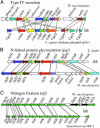Complete genome sequence and analysis of Wolinella succinogenes
- PMID: 14500908
- PMCID: PMC208819
- DOI: 10.1073/pnas.1932838100
Complete genome sequence and analysis of Wolinella succinogenes
Abstract
To understand the origin and emergence of pathogenic bacteria, knowledge of the genetic inventory from their nonpathogenic relatives is a prerequisite. Therefore, the 2.11-megabase genome sequence of Wolinella succinogenes, which is closely related to the pathogenic bacteria Helicobacter pylori and Campylobacter jejuni, was determined. Despite being considered nonpathogenic to its bovine host, W. succinogenes holds an extensive repertoire of genes homologous to known bacterial virulence factors. Many of these genes have been acquired by lateral gene transfer, because part of the virulence plasmid pVir and an N-linked glycosylation gene cluster were found to be syntenic between C. jejuni and genomic islands of W. succinogenes. In contrast to other host-adapted bacteria, W. succinogenes does harbor the highest density of bacterial sensor kinases found in any bacterial genome to date, together with an elaborate signaling circuitry of the GGDEF family of proteins. Because the analysis of the W. succinogenes genome also revealed genes related to soil- and plant-associated bacteria such as the nif genes, W. succinogenes may represent a member of the epsilon proteobacteria with a life cycle outside its host.
Figures



References
MeSH terms
Substances
Associated data
- Actions
LinkOut - more resources
Full Text Sources
Other Literature Sources
Molecular Biology Databases

